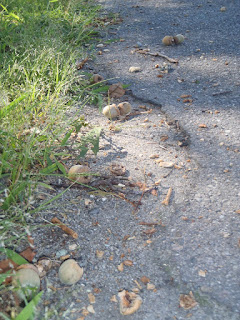The local oaks have begun dropping their acorns, and stately Northern Red Oak (Quercus rubra) is first. Since oaks are rather tricky things to destinguish, it's handy to be able to use this time to pick them out of the crowd.
The many species of oaks come in two basic flavors (subgenera or "sections") here in eastern North America: those with round-lobed leaves, and acorns that mature in one growing season and are more sweet-tasting with acorn cups hairless inside, called the "white oak group"*; and those with bristle-lobed leaves, and bitter acorns that need two growing seasons to mature and have cups hairy on the inside, called the "red oak group."
Red Oak has leaves that are generally "more leaf than hole," while roughly-similar black, scarlet and pin oaks are often "more hole than leaf." In Red Oak the acorn cap covers only the end of the nut, whereas other local trees in its group have caps that surround much more. (White Oak, which will begin dropping acorns soon, has nuts with a similar "beret," but these are easy to distinguish, since that beret has a very bumpy surface, unlike the nearly smooth caps of Red Oak.)
Northern Red Oak is an important forest tree throughout the eastern US, and its acorns--bitter though they are--are food for many animals. It is the only one of its local sibling species that has bark with stripes that run all the way down the trunk--even on large trees.
*This also includes Southern Live Oak, the famous deep South tree iconically Spanish moss covered. It has entire (unlobed) leaves that are green almost year-round. (If you want to see Live Oak here, visit Old Ironsides in Boston Harbor: it is framed and planked with its tough, dense wood.)
The many species of oaks come in two basic flavors (subgenera or "sections") here in eastern North America: those with round-lobed leaves, and acorns that mature in one growing season and are more sweet-tasting with acorn cups hairless inside, called the "white oak group"*; and those with bristle-lobed leaves, and bitter acorns that need two growing seasons to mature and have cups hairy on the inside, called the "red oak group."
Red Oak has leaves that are generally "more leaf than hole," while roughly-similar black, scarlet and pin oaks are often "more hole than leaf." In Red Oak the acorn cap covers only the end of the nut, whereas other local trees in its group have caps that surround much more. (White Oak, which will begin dropping acorns soon, has nuts with a similar "beret," but these are easy to distinguish, since that beret has a very bumpy surface, unlike the nearly smooth caps of Red Oak.)
Red Oak branchlet with a mature acorn begun last spring, and tiny acorns (looking a bit like buds) in pairs in the axil of each leaf. (A bite mark on the end shows a bad-mannered squirrel cut it down.)
If reproduction is a chancy business in the best of circumstances, it is much more so for a city tree. Car tires and shoe soles end the careers of many oak babies once they've fallen.
Northern Red Oak is an important forest tree throughout the eastern US, and its acorns--bitter though they are--are food for many animals. It is the only one of its local sibling species that has bark with stripes that run all the way down the trunk--even on large trees.
*This also includes Southern Live Oak, the famous deep South tree iconically Spanish moss covered. It has entire (unlobed) leaves that are green almost year-round. (If you want to see Live Oak here, visit Old Ironsides in Boston Harbor: it is framed and planked with its tough, dense wood.)



No comments:
Post a Comment